Imagine transforming your living space into a lush oasis of vibrant colors and exotic beauty, all centered around the enchanting Begonia Rajah. Having personally marveled at the stunning foliage of this extraordinary plant, I can attest to the magic it brings to any environment.
Now, let’s delve into the key aspects that make the Begonia Rajah a must-have addition to your botanical collection.
Key Takeaways
- Regal Origin: The Begonia Rajah, native to the rainforests of Southeast Asia, boasts a regal lineage that enhances its allure. Originating from the begoniaceae family, this plant has adapted to thrive in the tropical climates of countries like Malaysia and Indonesia.
- Striking Colors: What sets the Begonia Rajah apart is its mesmerizing color palette. With leaves resembling intricate stained glass, ranging from deep greens to fiery reds, this begonia commands attention and adds a touch of exotic elegance to any space.
- Unique Leaf Structure: One of the standout features is the distinctively textured foliage. The leaves are not only large but also adorned with intricate patterns, making each leaf a work of art. The pronounced veins and serrated edges contribute to the plant’s overall aesthetic appeal.
- Compact Size, Big Impact: Unlike some larger begonia varieties, the Rajah remains relatively compact, making it an ideal choice for both indoor and outdoor settings. Its manageable size doesn’t compromise its visual impact, making it suitable for various spaces, from windowsills to garden beds.
- Seasonal Flair: The Begonia Rajah is a seasonal delight, displaying different shades and patterns depending on the time of year. This ever-changing aspect adds an element of surprise, keeping both novice and seasoned plant enthusiasts captivated.
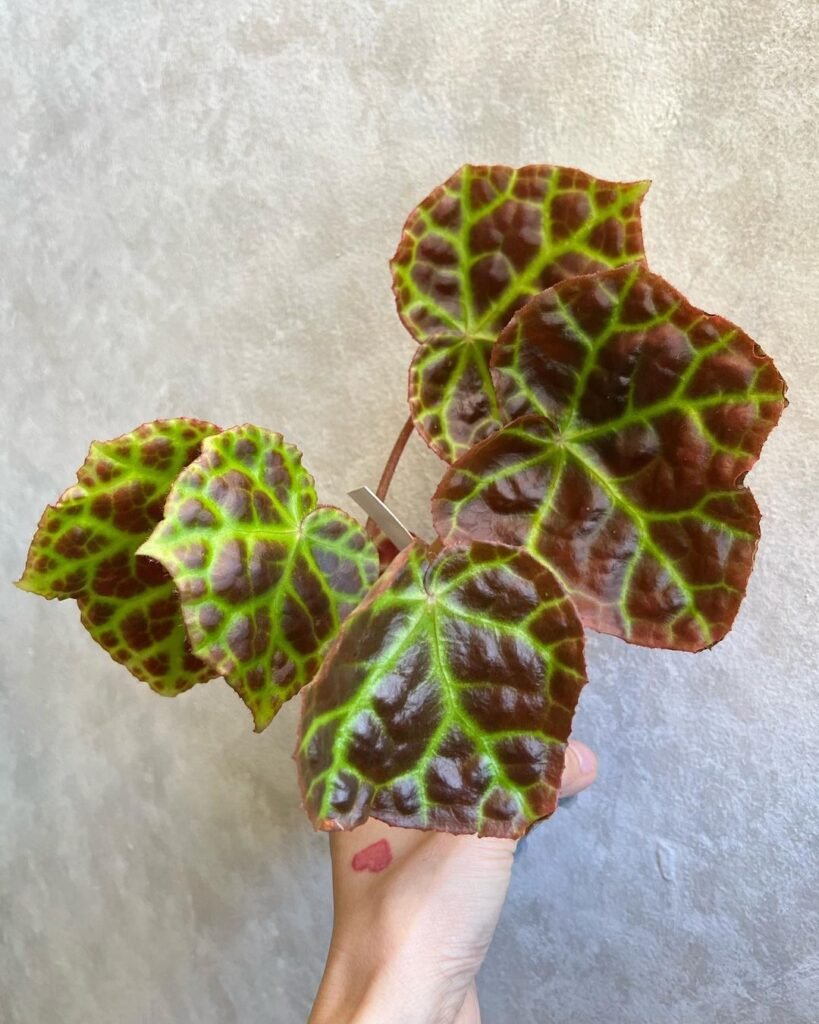

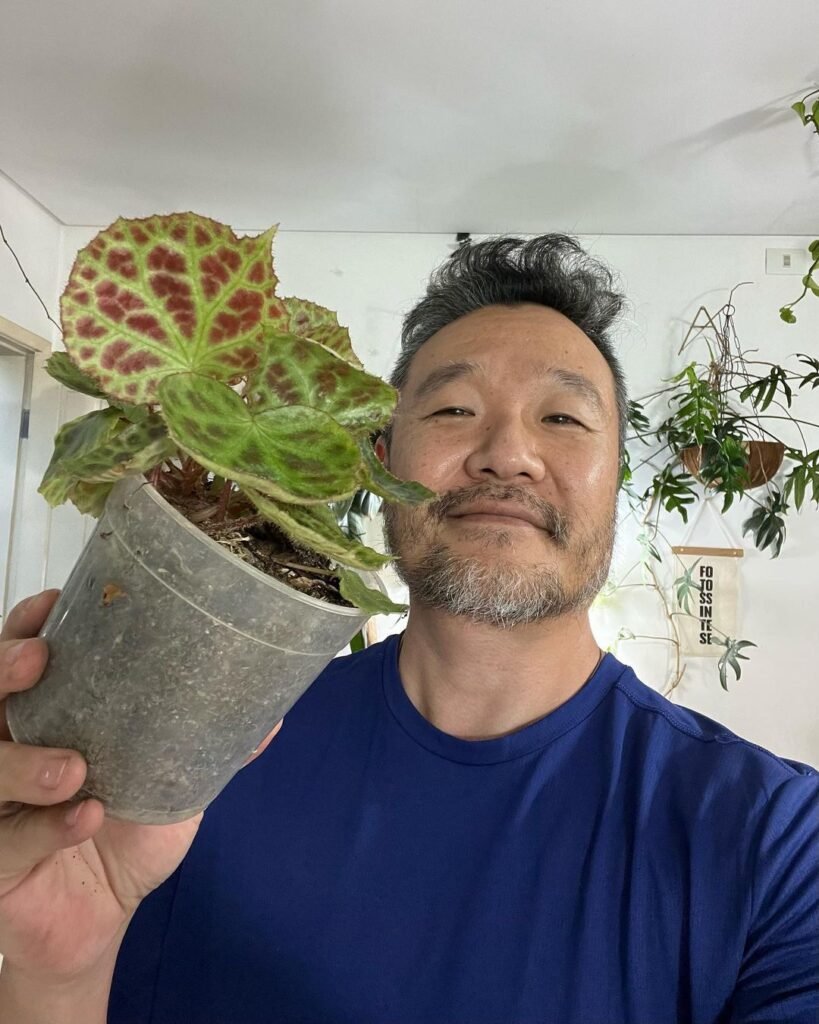
Care Guide Overview
| Care Aspect | Care Details |
|---|---|
| 💧 Watering | – Keep the soil consistently moist but not waterlogged. |
| – Water sparingly during the dormant winter period. | |
| – Ensure proper drainage to prevent root rot. | |
| ☀️ Lighting | – Provide bright, indirect light for optimal growth. |
| – Shield from direct sunlight, as it may scorch the leaves. | |
| 🌱 Soil and Fertilizing | – Opt for a well-draining potting mix rich in organic matter. |
| – Feed with a balanced, water-soluble fertilizer every 4-6 weeks during the growing season. | |
| 🌡️ Humidity and Temperature | – Maintain a high humidity level around 50-60%. |
| – Keep temperatures between 65°F to 75°F (18°C to 24°C), avoiding drastic fluctuations. | |
| ✂️ Pruning and Shaping Tips | – Trim leggy stems to promote a full, bushy appearance. |
| – Regularly remove any yellow or damaged leaves. | |
| 🌱 Propagation Tips | – Propagate through stem cuttings or rhizome division during the growing season. |
| – Ensure the new plants have at least two leaves and some roots before transplanting. |
Appearance of Begonia Rajah

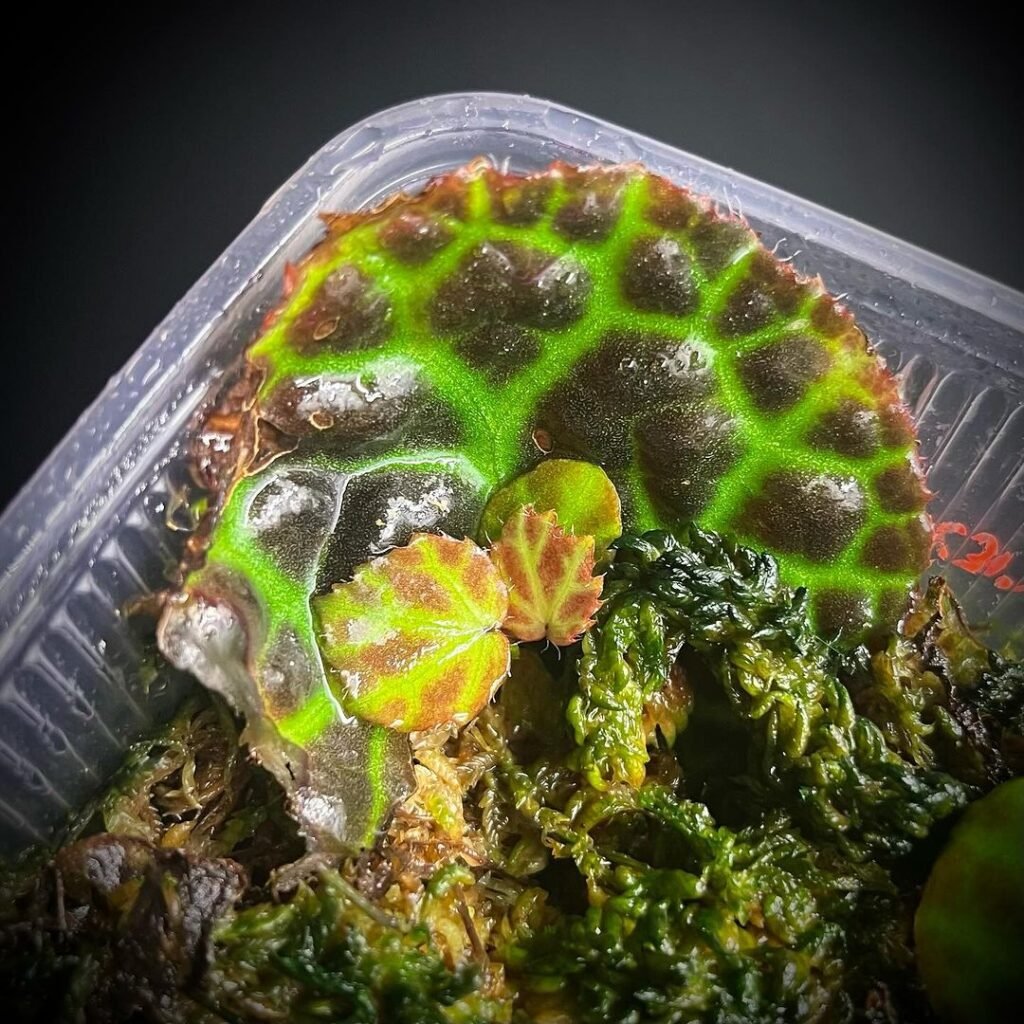
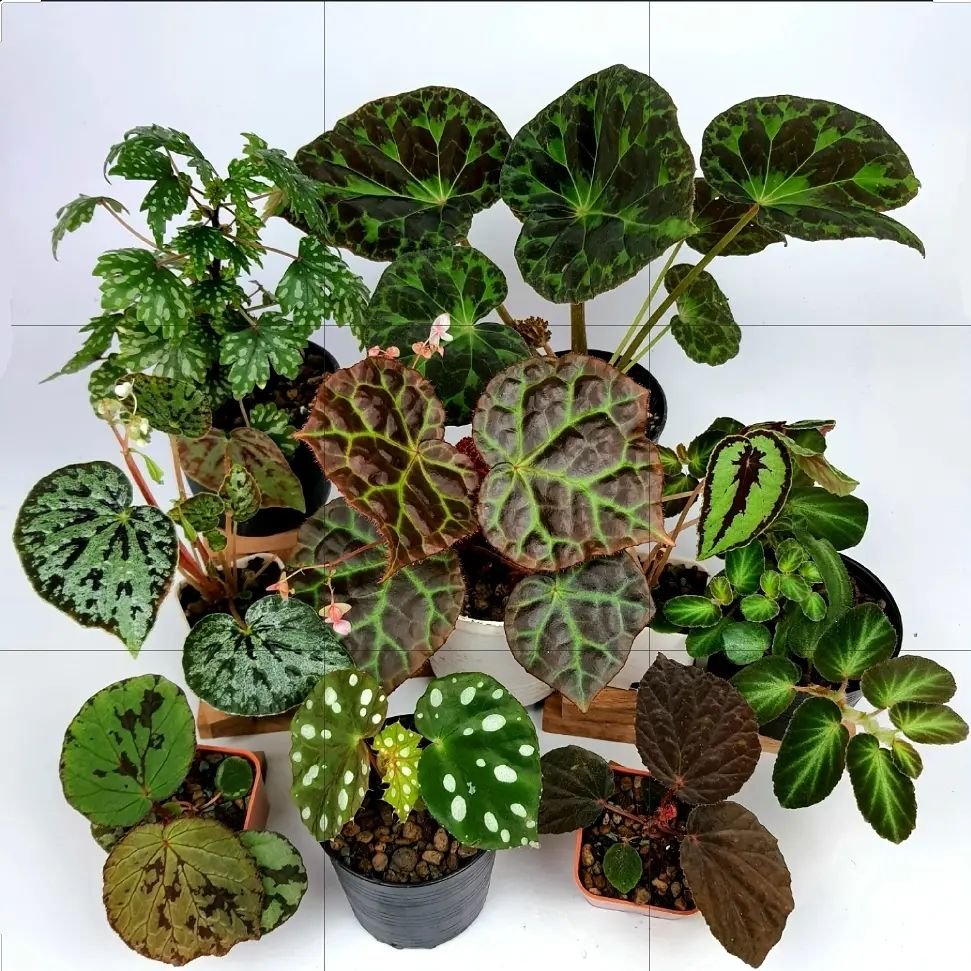
The Begonia Rajah is a botanical masterpiece, captivating observers with its distinctive appearance. Its leaves, the crown jewel of this begonia, are large and asymmetrical, boasting an array of bold and vivid colors. The surface of each leaf is a canvas painted with intricate patterns, resembling a mosaic of nature’s finest artistry. What makes the Rajah truly remarkable is the presence of a stunning silver iridescence that dances across the surface, catching the light in a way that seems almost magical.
Adding to its allure, the Begonia Rajah exhibits a compact yet robust growth habit, with stems that elegantly arch, showcasing the lush foliage in a graceful display. The undersides of the leaves, a contrasting deep burgundy or maroon hue, contribute to the overall visual drama.
Not the plant for you? Check out my full list of 78 Types of Begonia!
How to Grow Begonia Rajah
Growing the captivating Begonia Rajah is a rewarding journey, and mastering the key elements of its care is essential for success. Let’s dive into the specifics of nurturing this botanical marvel.
💧 Watering
- Consistent Moisture: Keep the soil consistently moist without allowing it to become waterlogged. A regular watering schedule, adjusting for seasonal variations, ensures the Begonia Rajah thrives.
- Winter Dormancy: During the dormant winter period, water sparingly to prevent overhydration. Allow the top inch of soil to dry out between waterings.
- Proper Drainage: Ensure the pot or planting area has adequate drainage to prevent water from stagnating around the roots, which can lead to root rot.
Care Tip: Use a saucer beneath the pot to catch excess water, preventing it from standing and potentially causing root issues.
☀️ Lighting
- Bright, Indirect Light: Provide the Begonia Rajah with bright, indirect light for optimal growth. Filtered sunlight or placement near a north-facing window is ideal.
- Sunlight Protection: Shield the plant from direct sunlight, especially during the intense midday hours, as prolonged exposure can scorch the leaves.
Care Tip: Rotate the plant periodically to ensure all sides receive equal sunlight, promoting even growth.
🌱 Soil and Fertilizing
- Well-Draining Mix: Choose a well-draining potting mix rich in organic matter to support healthy root development. A mix designed for tropical plants works well for Begonia Rajah.
- Balanced Fertilization: Feed the plant with a water-soluble fertilizer every 4-6 weeks during the growing season. Opt for a balanced formulation to provide essential nutrients.Care Tip: Dilute the fertilizer to half the recommended strength to avoid over-fertilizing, which can harm the plant.
🌡️ Humidity and Temperature
- High Humidity: Maintain a high humidity level around 50-60% to mimic the Begonia Rajah’s native tropical environment.
- Temperature Range: Keep temperatures between 65°F to 75°F (18°C to 24°C), avoiding sudden fluctuations. Protect the plant from drafts and cold temperatures.
Care Tip: Grouping plants together or using a humidifier can help maintain optimal humidity levels.
🌿 Choosing the Right Pot for Begonia Rajah
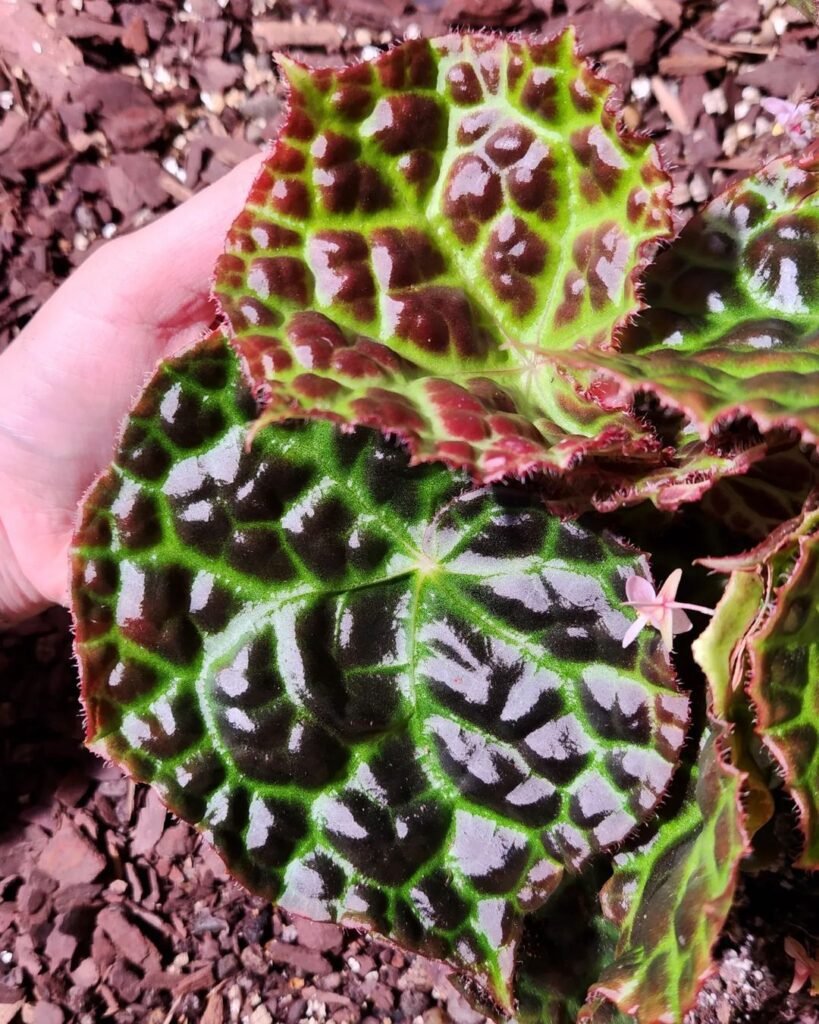


Selecting the proper pot for your Begonia Rajah is a crucial step in ensuring its well-being. Opt for a pot with good drainage holes to prevent water from pooling at the bottom, which can lead to root rot—something your Begonia won’t appreciate.
Consider the size of the pot too. While the Begonia Rajah doesn’t mind a bit of coziness, a pot that’s too small may stifle its growth. On the other hand, a pot that’s excessively large can lead to overwatering issues. Strike a balance, and your Begonia will thank you with robust and healthy foliage.
Care Tip: Add a layer of pebbles or broken terracotta pieces at the bottom of the pot to enhance drainage, creating an environment that mimics the well-aerated soils of its native habitat.
🌸 Beyond the Blooms: Understanding Begonia Rajah’s Flowering Cycle
While the Begonia Rajah is cherished for its striking foliage, understanding its flowering cycle adds an extra layer of appreciation. Typically, this begonia blooms during the spring and summer months, presenting clusters of delicate flowers that complement its vibrant leaves.
To encourage prolific flowering, maintain a consistent care routine, paying special attention to lighting and fertilization. The plant tends to focus its energy on flowering during the growing season, rewarding you with a burst of color. However, don’t be disheartened if your Begonia doesn’t bloom continuously—it’s the foliage that steals the show.
Care Tip: Gently remove spent flowers to redirect the plant’s energy back to leaf and stem growth, ensuring a continuous display of its captivating foliage.
🌱 Begonia Rajah: The Art of Propagation

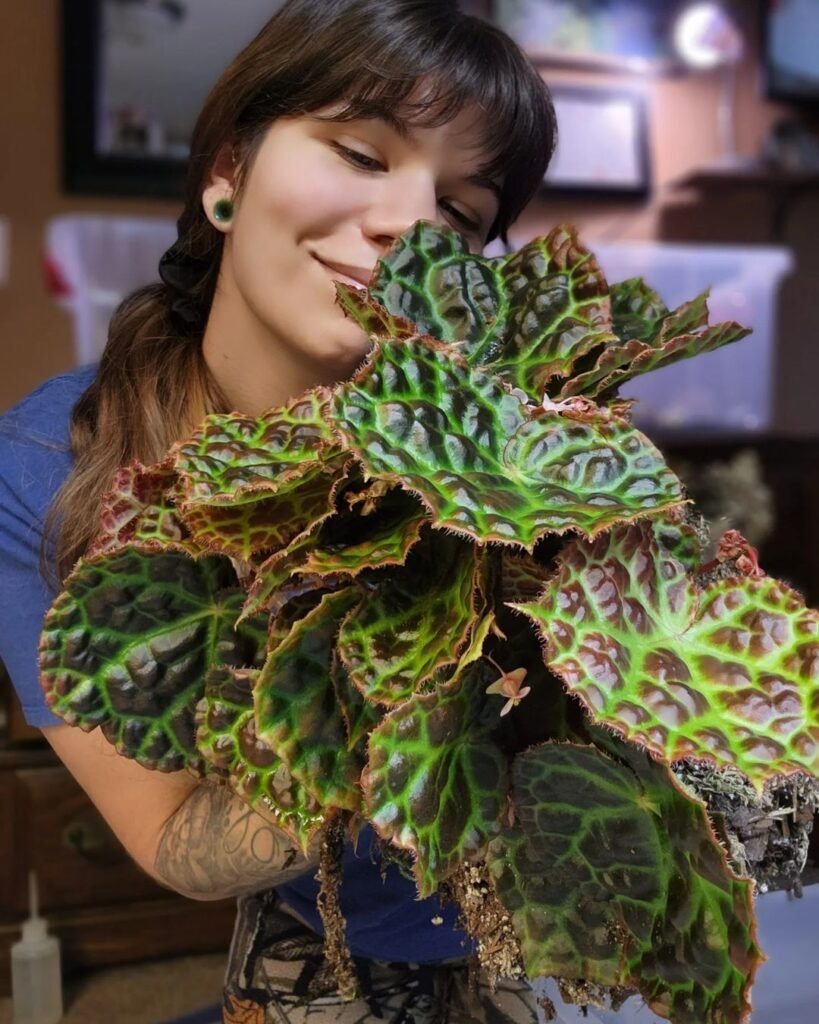
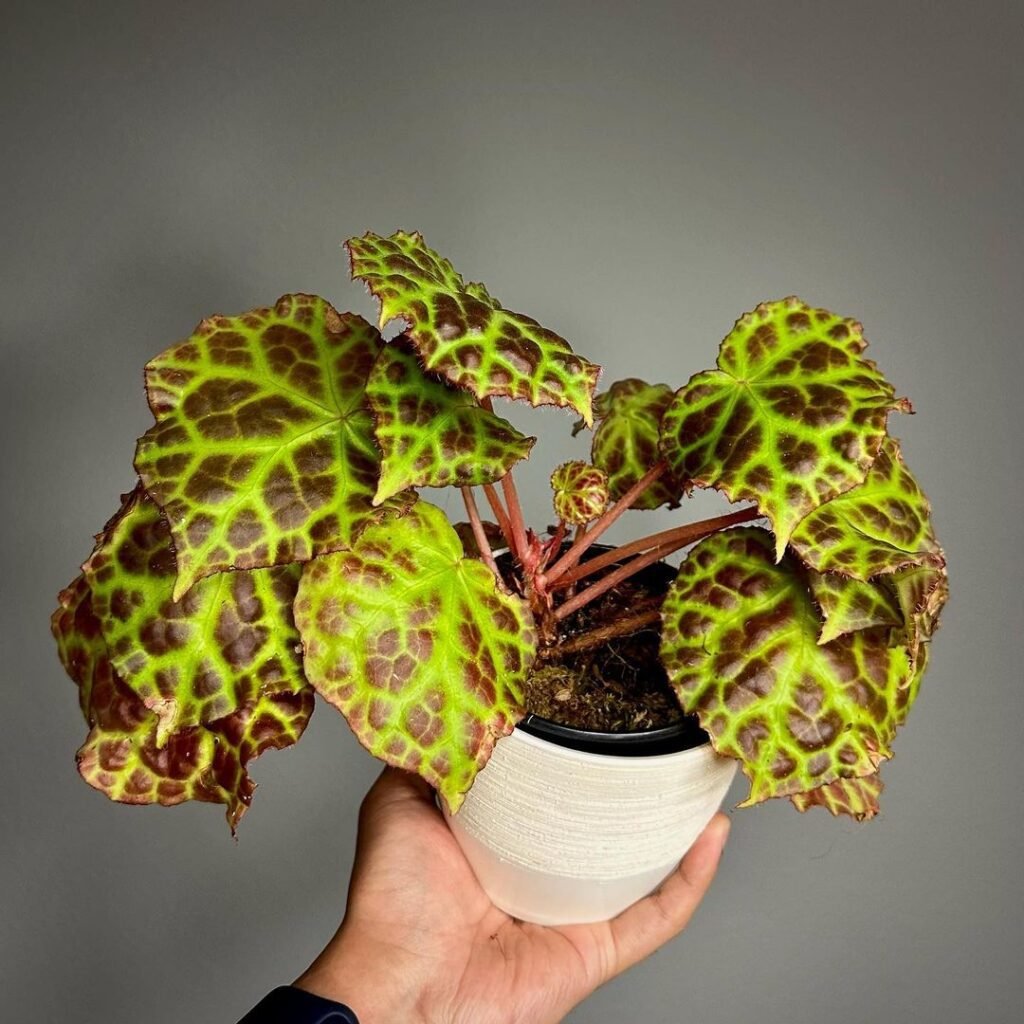
Understanding how to propagate your Begonia Rajah opens the door to expanding your botanical family. While the process may sound complex, it’s surprisingly straightforward, and it’s an excellent way to share the beauty of this begonia with friends or cultivate new plants for different spaces in your home.
Propagation Methods:
- Stem Cuttings: Select a healthy, non-flowering stem and cut it just below a leaf node. Remove the lower leaves, leaving a few at the top. Plant the cutting in a well-draining mix and keep it consistently moist. Roots should develop in a few weeks.
- Rhizome Division: During the growing season, gently separate the rhizomes (horizontal stems) that have at least two healthy shoots. Plant each division in its pot, ensuring the roots are well-covered with soil.
Care Tip: Propagate in the spring or early summer when the Begonia Rajah is in an active growth phase for optimal success.
🍃 Seasonal Adjustments: Adapting Care for Fall and Winter
As the seasons change, so do the needs of your Begonia Rajah. Transitioning your care routine during the fall and winter ensures the well-being of your plant, preparing it for potential challenges posed by cooler temperatures and reduced sunlight.
Fall Care:
- Reduce Watering: With the decrease in light and lower temperatures, scale back on watering to prevent overhydration.
- Monitor Light Exposure: Adjust the plant’s location to receive the available natural light, as the sun’s angle changes during the fall.
Winter Care:
- Limit Fertilization: During the dormant period, refrain from fertilizing to align with the reduced growth rate.
- Maintain Humidity: Counter the dry indoor air by providing adequate humidity, either through a humidifier or pebble trays filled with water.
Care Tip: Regularly inspect your Begonia Rajah for any signs of stress or disease during the fall and winter, intervening promptly to keep it in optimal health.
🌱 Begonia Rajah: Tackling Common Pests and Issues
Despite its resilience, the Begonia Rajah is not immune to common pests and issues that can affect its well-being. Understanding how to identify, prevent, and address these problems ensures your begonia remains in prime condition.
Common Pests:
| Pest | Identification | Prevention and Treatment |
|---|---|---|
| Spider Mites | Fine webbing on leaves, stippling, and discoloration. | Increase humidity, regularly shower the foliage, and use insecticidal soap or neem oil. |
| Aphids | Small, soft-bodied insects clustering on new growth. | Remove aphids manually, spray with a strong stream of water, or use insecticidal soap. |
| Mealybugs | White, cotton-like masses on leaves and stems. | Wipe off with a cotton swab dipped in rubbing alcohol, isolate affected plants, and treat with insecticidal soap. |
| Scale Insects | Hard, shell-like coverings on leaves and stems. | Scrub off with a soft brush or sponge, apply neem oil or horticultural oil, and introduce natural predators like ladybugs. |
Care Tip: Regularly inspect the undersides of leaves and stems for early pest detection, allowing for prompt intervention.
🌞 Optimal Light Conditions for Begonia Rajah: A Quick Guide
Providing the right amount of light is key to the success of your Begonia Rajah. This quick guide outlines the optimal light conditions to keep your begonia thriving.
Light Intensity:
| Light Level | Description | Suitability |
|---|---|---|
| Bright Indirect Light | Filtered sunlight, no direct exposure. | Ideal for Begonia Rajah, promotes healthy growth. |
| Partial Shade | Limited exposure to direct sunlight, shaded conditions. | Suitable, especially to protect from harsh midday sun. |
| Low Light | Dimly lit areas, away from direct sunlight. | Not recommended, as it may lead to leggy growth. |
Care Tip: Rotate your Begonia Rajah periodically to ensure all sides receive equal light, preventing lopsided growth and promoting a balanced appearance.
🌿 Enhancing Begonia Rajah’s Growth: Root Health Matters
Understanding and promoting the health of your Begonia Rajah’s roots is a fundamental aspect of ensuring its overall well-being. Strong and vibrant roots contribute to a thriving plant, and this section guides you through the essentials.
Root Health Tips:
- Well-Draining Soil: Ensure the plant sits in a well-draining potting mix, preventing waterlogging that can lead to root rot.
- Adequate Pot Size: Choose a pot that allows the roots to spread comfortably. A pot that’s too small may constrict growth, while one too large may lead to overwatering.
- Regular Inspections: Periodically check the roots for any signs of discoloration, mushiness, or an unpleasant odor, indicating potential issues.
Care Tip: If repotting is necessary due to crowded or unhealthy roots, do so during the growing season for minimal stress on the plant.
🌱 Begonia Rajah and Companion Plants: A Green Harmony
Creating a harmonious environment for your Begonia Rajah involves thoughtful selection of companion plants. Certain plant pairings can enhance growth, deter pests, and provide an aesthetically pleasing display.
Ideal Companions:
- Ferns: The delicate fronds of ferns complement the bold foliage of Begonia Rajah while thriving in similar humidity conditions.
- Calathea Varieties: These plants share a preference for bright, indirect light and high humidity, creating a visually striking combination.
- Pothos: With its trailing vines, Pothos adds a dynamic element to the display, contrasting the upright growth of Begonia Rajah.
If you’re thinking of extending your begonia family, I recommend considering either begonia medora or begonia richmondensis. They both would make great additions to your squad!
Care Tip: Consider the water and light requirements of both Begonia Rajah and its companions to ensure compatibility and a flourishing green ensemble.
Conclusion
In cultivating the beguiling Begonia Rajah, you’ve embarked on a journey that goes beyond simple plant care. From understanding its regal appearance to mastering the nuances of growth, you’ve become the steward of a botanical masterpiece. Remember, the key to a flourishing Begonia Rajah lies in a blend of dedication, observation, and a touch of green-thumb intuition.
As you witness the captivating colors and patterns unfold, take pride in nurturing a plant that thrives not only on care but on the connection forged between you and nature. The Begonia Rajah is more than a decorative addition; it’s a living testament to the artistry present in the world of flora.
FAQs
What is the ideal temperature range for Begonia Rajah?
The Begonia Rajah thrives in temperatures between 65°F to 75°F (18°C to 24°C). It’s essential to maintain a relatively stable environment, avoiding drastic fluctuations.
Can Begonia Rajah tolerate direct sunlight?
While it prefers bright, indirect light, the Begonia Rajah should be shielded from direct sunlight, especially during the intense midday hours. Prolonged exposure to direct sunlight may scorch its leaves.
How often should I water my Begonia Rajah during winter?
During the dormant winter period, reduce watering and allow the top inch of soil to dry out between waterings. This helps prevent overhydration, supporting the plant’s natural growth cycle.
Is Begonia Rajah suitable for low-light conditions?
No, Begonia Rajah does not thrive in low-light conditions. It requires bright, indirect light for optimal growth. Placing it in dimly lit areas may result in leggy growth and diminished vibrancy.
How can I encourage flowering in Begonia Rajah?
To encourage prolific flowering, ensure consistent care, focusing on factors such as lighting and fertilization. While the Begonia Rajah is known for its foliage, maintaining a well-rounded care routine supports occasional blooming during the growing season.
Is Begonia Rajah prone to any common pests?
Yes, like many plants, Begonia Rajah can be susceptible to pests such as spider mites, aphids, mealybugs, and scale insects. Regular inspection and prompt intervention are key to addressing these issues.
Can Begonia Rajah be grown outdoors?
Yes, Begonia Rajah can be grown outdoors in suitable climates. Ensure it is planted in well-draining soil, receives filtered sunlight, and is protected from extreme weather conditions.
Is Begonia Rajah suitable for beginners?
While Begonia Rajah is generally resilient, its care requirements may pose a challenge for beginners. With proper research and attention to its specific needs, enthusiasts of all levels can enjoy cultivating this stunning begonia.

Writer/Green Thumb/Explorer – Rooted deep in the rich soils of Devon, I’ve cultivated a vast expertise in plant care, helping greenery thrive in homes across the UK. When I’m not crafting detailed plant care guides, I’m journeying through the lush landscapes of the West Country, unearthing nature’s secrets and sharing them with fellow plant enthusiasts. Every leaf has a story, and I’m here to tell it.





